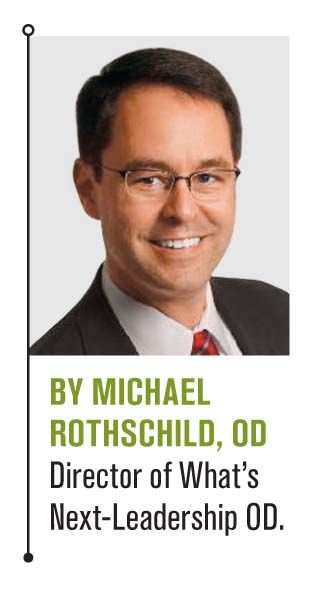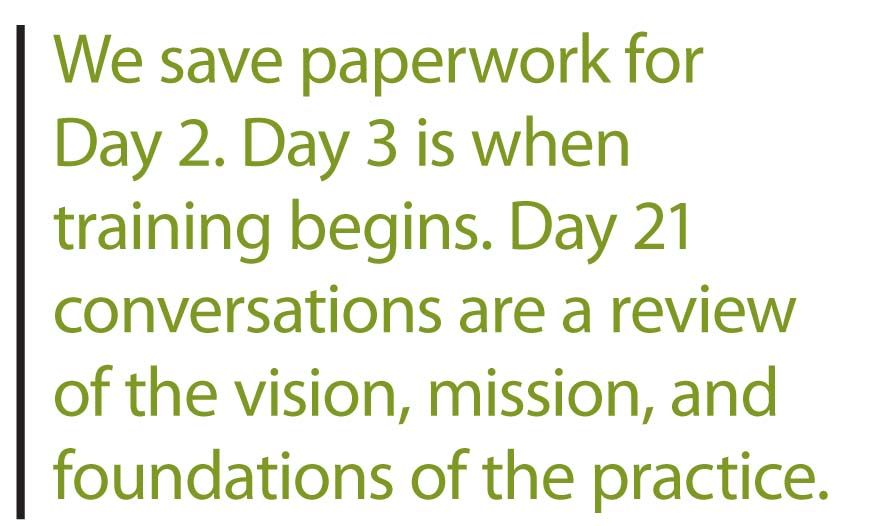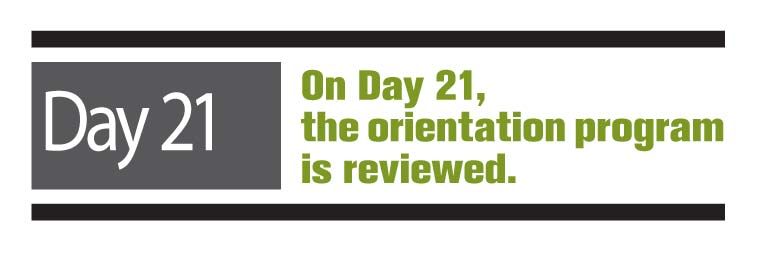Getting your staff off to a great start
One of the most stressful days in a person's life is the first day on a new job. If you remember the first day at your current job, you can probably remember the discomfort of walking into an unfamiliar place, not knowing where to put your stuff, and being nervous that you may have made a big mistake by accepting this job.

One of the most stressful days in a person's life is the first day on a new job. If you remember the first day at your current job, you can probably remember the discomfort of walking into an unfamiliar place, not knowing where to put your stuff, and being nervous that you may have made a big mistake by accepting this job. These are very common feelings that people have when they are beginning a new job.
It is also very well known that a strong staff can separate one practice from another. Most optometry offices have similar basic concepts, similar business model, and similar strategies. What sets one office apart from another is the people who run it. Walt Disney said it best when he said, "You can dream, create, design, and build the most wonderful place in the world, but it requires people to make the dream a reality.” This concept is well documented in many business acumens.
Training in optometry practices
In optometry offices, we do not routinely hire new people. Our businesses for the most part are small and turnover typically is relatively low. If we hire more than a handful of people in a year, it is usually because of an extraordinary event. So, we typically don't have human resources experts, much less a human resources department.
And another difficult component in our hiring practices is that we hire people only when our situation is stressed because we are short-handed due to unprecedented growth or because someone has quit (or been fired).
Because we don't have a lot of experience with hiring new people, we should be diligent in making sure we are ready when it does occur. In essence, it’s like the fire drills that you have at school. It is just going through the motions to make sure that if the event does happen that you are actually ready and things go off without a hitch.
I was fortunate enough to receive training from the Ritz Carlton Hotel on its orientation. This training is available through its business leadership program and was a vital part of the development of my program.
At the Ritz Carlton, its employees are treated very special on their first day. These are people who are acquiring jobs as housekeepers, cooks, and bartenders. They all have their car valet parked on the first day so that they can see how good it feels to be treated special. The general manager of the hotel dedicates a day to the new group of employees demonstrating the importance of their new role within the organization.
This dedication to making the new employee feel special is consistent throughout its training program. The first day is spent reviewing the principles and concepts that the Ritz Carlton is based on because the company believes it is vitally important that every team member understands that it is an organization that is made up of “ladies and gentlemen serving ladies and gentlemen.”
Contrast that to a typical first day in an optometry practice. A new employee will walk up to the front desk and not be recognized. The receptionist may or may not know that someone new is starting today but certainly doesn't know how to instruct her. So, she is left at the front desk, while the receptionist reminds the doctor that the new employee is starting today. And the training begins with shadowing of the employee who has just quit. We certainly have some lessons to learn.
We have developed an orientation program within our office, and we have shared it through many lectures and webinars, and we have implemented this in many of our clients’ offices. While it certainly must be personalized for each individual office, it simply asks you to do two things: first, prepare and second, save for next time.
Prepare
When we say prepare for an orientation program, all we are saying is to take some time to run through the drill. Design a perfect first week for new employees while there is no one new working in the office. Ask your newest employees about their first day and ask them to explain their feelings.
Again, optometry practices typically do not hire new people, so we have to learn every time. If there is an organized system to keep up with the orientation lessons from each time and build on it when a new employee is hired, improvements can be made, and eventually, you will wind up with a program that is a perfect fit for your office.
How patients perceive your practice
Be ready, be special, and be present
The vision of our orientation program is to accomplish these three things:
• Be ready. Have the entire staff know that someone new is starting. They are all aware that there is a hiring going on and while it does make logical sense, but the entire team will be nervous for someone new coming into the organization. It is vital that someone recognizes the new employee walking into the door and is there to greet and knows what to do when she arrives. There is not another chance to make a first impression. The entire team needs to be ready before that day. At our office we have daily meetings at 1 p.m., so that it is always discussed when the new employee will start and someone is assigned to wait for her to arrive.
• Be special. Remember this is a very stressful day for a new employee. She will remember it for a long time, and it can be a positive or a negative experience. It is important to put a plan in place to make it a special day. Our strategy is to find out what the new employee’s favorite candy is and present it to her as we introduce her at our daily meeting. This is an experience that is repeated over and over and is something that we use to explain how we want our patients to feel.
• Be present. It is easy for new employees to get lost in the shuffle of a busy workday. It is critical to make sure that the new employee’s needs are taken care of during the entire week. It is not essential that other staff members are with her all the time but someone must be responsible for making sure that the new employee is always taken care of.
The first week

On Day 1 of employee orientation, it is important to get off to a good start. Make sure that someone is ready to greet the new employee as she walks into the door. Show her immediately where to put her belongings and where the bathroom is located. Then, show the new team member around the office. Then, we assign one person to begin her orientation process.
We have several materials that reflect the foundation of our business, including the history of our practice and other documents, which are reviewed in detail for at least half of a day.
Whoever is leading the training is responsible for asking the new team member her favorite candy. Later, another team member purchases that favorite candy and gives it to her at the daily meeting. The new employee recognizes that this gift is special for her and we put energy into giving her something unique.
After the meeting, the orientation conversation about our foundation principles continues. The first day always ends earlier than we say.
We save necessary employee paperwork for the second day. It is never pleasant to fill out a lot of paperwork, and if the employee decides to not return the second day, then at least you have saved some trees. Once the paperwork is completed, the foundational training continues.
Day 3 is when training begins. Training is the part of an orientation program that is job specific. It is when technicians begin to learn about visual acuities and auto refractors. It is when frame stylists begin to learn the different brands that we carry and our frame selection process. The training goes in three steps that we qualify as:
• Watch me.
• I'll watch you.
• I'll check back with you to help.
It is important that all three of these steps are followed to assure that training is done properly. It is far too common for new employees to be "let go" in a new role simply because we feel it is an easy job. The training should be planned out for at least two weeks in advance based on the job and the prioritized needs of the offices. It is important that this is spelled out for everyone in the office so that it can be coordinated.
The more that this is planned out in advance, the more proactive and active the training will be. This leads to effective training that builds confidence in employees. The training continues throughout the employee’s lifetime within the practice.

The first month
On Day 21, the orientation program is reviewed. After 21 days, an employee has begun to feel comfortable and understand the nuances of the practice. It is becoming clearer if this person truly is a good fit for the practice.
Our Day 21 conversations are a review of the vision, mission, and foundations of the practice. It is an opportunity to review what is learned from the first day. A new employee is likely very stressed on the first day, so it is important to go over that information again when they are more comfortable.
It also shows the new employee that even though we are not perfect, our ideals remain the same and we continue to strive toward them. It is also an opportunity to ask those new employees what they think we could do better. And finally, it is an opportunity to part ways. By stopping to have this two-way conversation about the direction of the practice and the goals of the person, it is a good way for them to get out.
This method is far more effective than a 90-day probation period, which can be far more threatening.
The first year
Day 365 concludes one year at the office and a celebration within the practice. By this time the new employee is truly a part of the family, she feels at home, and she is welcome. We strive to keep up with anniversary dates.
It should be noted that we do not give salary adjustments at the one-year anniversary. This is done with a different method, which I will share in a future department.
This strategic approach to an orientation program assures a great start and is the first step to building a strong team.
Newsletter
Want more insights like this? Subscribe to Optometry Times and get clinical pearls and practice tips delivered straight to your inbox.